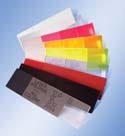January 6, 2005
Originally Published MPMN January 2005
INDUSTRY NEWS
Laser Welding Additives Eliminate Color Barrier
Norbert Sparrow
|
Despite its limitations, laser welding has made significant inroads as a joining technology of choice. Industry forecasters predict that it will capture 10% of the market in the medium term. Chemicals giant BASF (Florham Park, NJ; www.basf.com) hopes to drive that growth with an additive that allows polymers of any color to be laser welded. Flanked by partners Treffert Polymer-Technologie (Bingen, Germany; www.treffert.org) and Rofin/Baasel Lasertech (Boxborough, MA; www.rofin.com), BASF introduced the new product line at the recent K show in Düsseldorf, Germany.
Traditionally, laser-based materials joining requires the use of embedded absorbing additives, such as pigments or dyes. These additives often have a color of their own, limiting aesthetic options. Lumogen IR additives developed by BASF are unique in that they are part of the polymer matrix, stresses manager of new technology Arno Böhm. “One of our objectives was not to add any complexity to the process,” he says. “The material is simply added to the bottom substrate. No additional step is required to make the polymer weldable.”
Med-tech OEMs will be interested in the capability to laser-weld transparent polymers without traces of residual color or optical scattering, notes Clemens Karg, head of strategic marketing. In addition, the additives are nonionic and nontoxic, and contain no halogens or heavy metals, he says. “We have done exhaustive testing on our end,” says Böhm. “But final product testing can only be done by the customer, of course.”
|
Lumogen IR additives developed by BASF enable laser welding of transparent and colored polymers without the use of pigments or dyes. |
The additives can be used in standard plastics as well as engineering polymers such as polyamides, ABS, and polyester. Lumogen IR’s high absorption efficiency and thermal stability enables its use in materials with a high melting point such as polysulfone, polyetherimide, and PEEK.
Treffert Polymer-Technologie can supply a range of customer-specific master batches or compounds incorporating the Lumogen additives. The firm has been a leading developer of master batches for laser welding since the mid-1990s.
Because of Lumogen IR’s specific absorbing characteristics, it must be welded using diode lasers in the 808-nm wavelength. Rofin/Baasel Lasertech offers integratable diode lasers as well as complete systems suited for joining additive-laden materials.
Laser welding creates joints that almost equal the mechanical strength of the base material. The motion- and contact-free process produces no miniature particles during welding. An additional benefit is the ability to weld seams in micromechanical parts, vibration-sensitive membranes. and delicate electronic components.
Copyright ©2005 Medical Product Manufacturing News
You May Also Like




